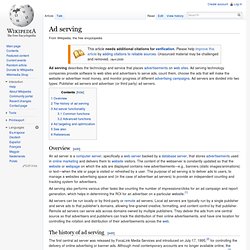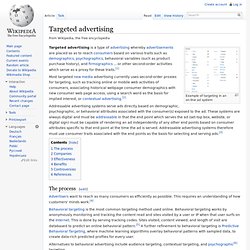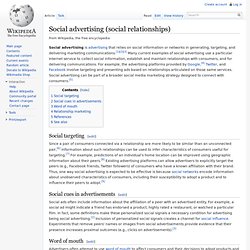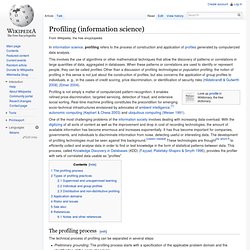

Ad serving - Wikipedia, l'encyclopédie libre. Ad serving describes the technology and service that places advertisements on web sites.

Ad serving technology companies provide software to web sites and advertisers to serve ads, count them, choose the ads that will make the website or advertiser most money, and monitor progress of different advertising campaigns. Ad servers are divided into two types: Publisher ad servers and advertiser (or third party) ad servers. Overview[edit] Ad serving also performs various other tasks like counting the number of impressions/clicks for an ad campaign and report generation, which helps in determining the ROI for an advertiser on a particular website.[1] Ad servers can be run locally or by third-party or remote ad servers. Contextual advertising. Contextual advertising is a form of targeted advertising for advertisements appearing on websites or other media, such as content displayed in mobile browsers.

The advertisements themselves are selected and served by automated systems based on the content displayed to the user. How contextual advertising works[edit] A contextual advertising system scans the text of a website for keywords and returns advertisements to the webpage based on those keywords. [1] The advertisements may be displayed on the webpage or as pop-up ads. For example, if the user is viewing a website pertaining to sports and that website uses contextual advertising, the user may see advertisements for sports-related companies, such as memorabilia dealers or ticket sellers.
Contextual advertising is also used by search engines to display advertisements on their search results pages based on the keywords in the user's query. Targeted advertising. Example of targeting in an on-line ad system Targeted advertising is a type of advertising whereby advertisements are placed so as to reach consumers based on various traits such as demographics, psychographics, behavioral variables (such as product purchase history), and firmographics ... or other second-order activities which serve as a proxy for these traits.[1] Most targeted new media advertising currently uses second-order proxies for targeting, such as tracking online or mobile web activities of consumers, associating historical webpage consumer demographics with new consumer web page access, using a search word as the basis for implied interest, or contextual advertising.[2] Addressable advertising systems serve ads directly based on demographic, psychographic, or behavioral attributes associated with the consumer(s) exposed to the ad.

The process[edit] Advertisers want to reach as many consumers as efficiently as possible. Social advertising. Social advertising (social relationships) Social advertising is advertising that relies on social information or networks in generating, targeting, and delivering marketing communications.[1][2][3] Many current examples of social advertising use a particular Internet service to collect social information, establish and maintain relationships with consumers, and for delivering communications.

For example, the advertising platforms provided by Google,[4] Twitter, and Facebook involve targeting and presenting ads based on relationships articulated on those same services. Profiling (information science) In information science, profiling refers to the process of construction and application of profiles generated by computerized data analysis.

The technical process of profiling can be separated in several steps: Data collection, preparation and mining all belong to the phase in which the profile is under construction. However, profiling also refers to the application of profiles, meaning the usage of profiles for the identification or categorization of groups or individual persons. As can be seen in step six (application), the process is circular. There is a feedback loop between the construction and the application of profiles. In order to clarify the nature of profiling technologies some crucial distinctions have to be made between different types of profiling practices, apart from the distinction between the construction and the application of profiles. Recommender system. Recommender systems or recommendation systems (sometimes replacing "system" with a synonym such as platform or engine) are a subclass of information filtering system that seek to predict the 'rating' or 'preference' that user would give to an item.[1][2] Recommender systems have become extremely common in recent years, and are applied in a variety of applications.

The most popular ones are probably movies, music, news, books, research articles, search queries, social tags, and products in general. Tracking system. Generally a tracking system is used for the observing of persons or objects on the move and supplying a timely ordered sequence of respective location data to a model e.g. capable to serve for depicting the motion on a display capability.

Tracking in virtual space[edit] In virtual space technology, a tracking system is generally a system capable of rendering virtual space to a human observer while tracking the observer's body coordinates. For instance, in dynamic virtual auditory space simulations, a real-time head tracker provides feedback to the central processor, allowing for selection of appropriate head-related transfer functions at the estimated current position of the observer relative to the environment. Tracking in real world[edit] There are a myriad of tracking systems. Distribution/Warehousing/Manufacturing[edit] However tracking could also be capable to provide monitoring data without binding to fixed location by using a cooperative tracking capability, e.g. an RTLS.
Jensen, R.